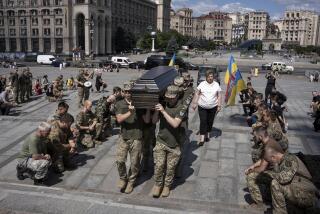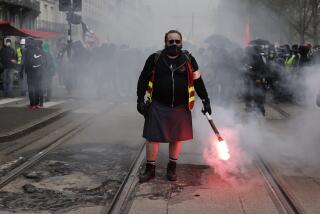Ceausescu Returns, Blames ‘Fascists’ : Romania: More protests reported as emergency is declared.
- Share via
WARSAW — With his army on full alert, the nation’s borders sealed and continuing protests against his police-state government, President Nicolae Ceausescu of Romania returned home from a visit to Iran on Wednesday and accused “fascists and reactionaries” and “imperialist espionage centers” for inciting the demonstrations.
In a rambling, 25-minute diatribe delivered on national television, the 71-year-old Ceausescu made no reference to casualties resulting from a reported clash Sunday between demonstrators and security forces in the western Romanian city of Timisoara.
That clash apparently left hundreds--some say thousands--dead or wounded. The casualty figures have not been confirmed by independent sources, since Romania’s borders have been virtually sealed since Monday. Border guards are allowing only long-haul truck drivers to pass through the country. But foreigners leaving Romania say the death toll may be more than 1,000.
The official East German news agency ADN reported Wednesday that 3,000 to 4,000 people had been killed over the past few days.
The Yugoslav news agency, Tanjug, and the Hungarian news agency, MTI--both with good sources in Romania--have reported that as many as 2,000 may have been killed when troops fired into the crowds Sunday from tanks and helicopters.
Tanjug reported new anti-government demonstrations in nine Romanian cities Wednesday, including Timisoara, where heavy concentrations of army and police did not intervene.
The demonstration in Timisoara on Wednesday was reported to have begun at a factory, where workers rallied and then went to a football stadium where, according to rumors, the bodies of those killed in Sunday’s violence had been taken.
The demonstrators--100,000 strong according to Hungarian television--then marched to the center of the city, chanting, “Give us our dead!”
Tanjug quoted unofficial sources as reporting that the Romanian military was on “full alert” and that reservists had been called to duty. A state of emergency was declared in Timisoara and the region around the city of about 300,000. The Romanian news agency Agerpres said an 11 p.m. curfew had been imposed and meetings of more than five people were prohibited in view of “the serious violation of public order in Timis county through acts of terrorism, vandalism and destruction of public assets.”
A spokesman for the U. S. Embassy in Bucharest reported that although the capital was quiet, unusual activity was evident in military facilities and “an increasing police and military presence in the streets.”
The Soviet news agency Tass reported that extra security personnel were on duty at state offices and factories.
In his television address, Ceausescu promised that “we will do everything to solve all the problems (to achieve) good cooperation with our working people.” But he made no direct reference to Timisoara and sounded unapologetic over the actions taken against the demonstrators.
He charged repeatedly that the demonstrations were the work of “hooligan elements” and “fascists who have continued and intensified the destruction of public institutions, shops and military units.” The “fascists,” he said, worked “in collusion with reactionary imperialist circles and espionage centers” to foment unrest.
“The aim of these anti-national provocative actions,” Ceausescu asserted, “was to provoke disorder and to create the conditions for the territorial dismemberment or Romania, of its independence and sovereignty.
“These are anti-national terrorist actions,” he declared, and accused neighboring Hungary, through Radio Budapest, of whipping up the protests.
The Hungarian and Romanian governments have been at odds for years over Romanian treatment of 1.7 million ethnic Hungarians living in Romania.
Hungarian Foreign Minister Gyula Horn told the Parliament in Budapest on Wednesday that security forces fired into the crowd in Timisoara on Sunday, killing or wounding hundreds. Horn added that the Rev. Laszlo Toekes, one of the country’s best-known human rights activists, had been taken from his home in Timisoara by police and that his whereabouts remains unknown.
In a protest delivered to the Romanian ambassador in Budapest, Horn said, the Hungarian government dismissed Romanian accusations of inciting unrest and said the protests grew out of the dissatisfactions of the Romanian population.
The demonstrations in Timisoara began in protest of continuing police harassment of Toekes.
According to reports of travelers and Romanian emigre sources, the center of Timisoara was devastated by the battle between the security forces and the demonstrators. Foreign truck drivers reported seeing houses and buildings ablaze, the city center reduced to wreckage and the streets lined with tanks and armored personnel carriers.
Helmut Wolf, an Austrian who arrived in Vienna on Wednesday, told Austrian Radio that “Sunday was brutal” in Timisoara, as the security forces fired into the crowd. He estimated that “more than 1,000” were killed. He said “tanks were everywhere” and “houses were on fire.”
On Wednesday, in addition to the protest in Timisoara, there were reports of protests in Brasov, Iasi, Arad, Ploiesti and smaller cities. In Iasi, people were reported burning books by Ceausescu.
More to Read
Sign up for Essential California
The most important California stories and recommendations in your inbox every morning.
You may occasionally receive promotional content from the Los Angeles Times.










